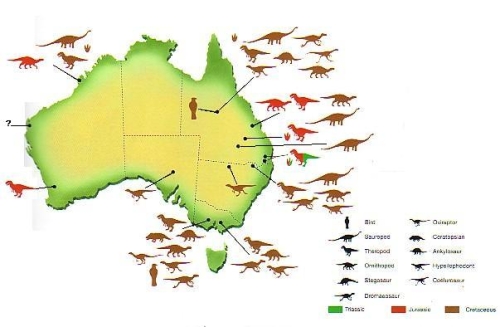
☆クイーンズランド州
クイーンズランド州恐竜
クイーンズランドの恐竜達は自由に徘徊し、plesiosaursプレシオサウルス、 ichthyosaursイチトサウルスやpliosaursプリオサウルスなどの海竜は海を支配していました。
彼らの化石は、クイーンズランド州の中部と西部の牧場砂岩に眠っています。
それらは1億年前の広大なエロマンガ海という名前の海に生存していました。
有史以前の動物を学習する場合、時には恐竜であるかどうかの間違いを呼び起こします。
簡単に言えば、恐竜とは土地に生息する生き物であり-彼らは4本脚を持ち、肺で息をしました。
恐竜は2億4800万年前から6500万年前までの間に住んでいました。
また、同期間にイチトサウルスのような海竜が住んでいましたが、それは確かに恐竜達と同じような
大きさと残忍さを持っていましたが恐竜とは呼ばれていません。
クイーンズランド州はプテロサウルスpterosaursのような翼竜のベース基地でもありました。
Queensland dinosaurs roamed the land, swimming reptiles such as plesiosaurs, pliosaurs and ichthyosaurs dominated the seas.
Their remains were preserved in rocks in central and western Queensland - site of a vast inland sea named Eromanga sea 100 million years ago.
When first learning about prehistoric animals, it is sometimes easy to get confused about what exactly is and isn't a dinosaur. Quite simply, we talk about dinosaurs as being land-based creatures - they had four legs, and breathed air through lungs. Dinosaurs lived between 248 million and 65 million years ago.
Also living in the same period were sea creatures such as the ichthyosaur, which could certainly be as large and ferocious as a dinosaur, but were not called dinosaurs.
Queensland was also home to some prehistoric animals of the sky such as Pterosaurs.
ロートサウルスRhoetosaurus | ミンマイMinmi(アンキロサウルス) | クイーンズランド州恐竜
クイーンズランドの恐竜達は自由に徘徊し、plesiosaursプレシオサウルス、 ichthyosaursイチトサウルスやpliosaursプリオサウルスなどの海竜は海を支配していました。
彼らの化石は、クイーンズランド州の中部と西部の牧場砂岩に眠っています。
それらは1億年前の広大なエロマンガ海という名前の海に生存していました。
有史以前の動物を学習する場合、時には恐竜であるかどうかの間違いを呼び起こします。
簡単に言えば、恐竜とは土地に生息する生き物であり-彼らは4本脚を持ち、肺で息をしました。
恐竜は2億4800万年前から6500万年前までの間に住んでいました。
また、同期間にイチトサウルスのような海竜が住んでいましたが、それは確かに恐竜達と同じような
大きさと残忍さを持っていましたが恐竜とは呼ばれていません。
クイーンズランド州はプテロサウルスpterosaursのような翼竜のベース基地でもありました。
Queensland dinosaurs roamed the land, swimming reptiles such as plesiosaurs, pliosaurs and ichthyosaurs dominated the seas.
Their remains were preserved in rocks in central and western Queensland - site of a vast inland sea named Eromanga sea 100 million years ago.
When first learning about prehistoric animals, it is sometimes easy to get confused about what exactly is and isn't a dinosaur. Quite simply, we talk about dinosaurs as being land-based creatures - they had four legs, and breathed air through lungs. Dinosaurs lived between 248 million and 65 million years ago.
Also living in the same period were sea creatures such as the ichthyosaur, which could certainly be as large and ferocious as a dinosaur, but were not called dinosaurs.
Queensland was also home to some prehistoric animals of the sky such as Pterosaurs.
ウイントン足跡化石trackways | 新竜脚類 |エリオット | クーパー&ジョージ
Australia Agrosaurus, Austrosaurus, Kronosaurus, Muttaburrasaurus, Platypterygius, Woolungosaurus
Australovenator (Banjo), Diamantinasaurus (Matilda) and Wintonotitan (Clancy) are the first dinosaurs to be named in Queensland in 28 years (Minmi and Muttaburrasaurus were named in 1980).
All 3 new dinosaurs were found in the Winton Formation, central western Queensland.
The Winton Formation is a geological deposit spread across much of inland Australia dating from 98-95 million years ago.
This geological resource has produced more dinosaur fossils than the rest of Australia combined.
See fossils from Banjo, Matilda and other Winton dinosaurs at the Australian Age of Dinosaurs* Museum of Natural History.
More dinosaur-themed exhibits are currently on show in ENERGEX Playasaurus Place and Museum Zoo at Queensland Museum South Bank in Brisbane.
Read the media release about the discovery of the 3 new species of dinosaurs announced in July 2009 .
Read the full scientific paper, New Mid-Cretaceous (Latest Albian) Dinosaurs from Winton, Queensland, Australia, published on-line in PLoS ONE, the Public Library of Science's new interactive open-access journal for scientific and medical research.

☆西オーストラリア州
ストラマトライト Ozraptor, many trackways
☆ニューサウスウエールズ州
Australia Fulgurotherium
☆ビクトリア州
Australia Allosaurus, Atlascopcosaurus, Ausktribosphenos*, Fulgurotherium, Leaellynasauria, "Quantassasaurus", Timimus
☆南オーストラリア州
Kakuru, Australia Agrosaurus, Allosaurus, Atlascopcosaurus, Ausktribosphenos*, Austrosaurus, Fulgurotherium, Kakuru, Kronosaurus*, Leaellynasauria, Minmi, Muttaburrasaurus, Ozraptor, Platypterygius*, Pterodactyloids*, Pterosaurs*, "Qantassaurus," Rapator, Rhoetosaurus, Timimus, Tylosaurus*, Walgettosuchus, Woolungosaurus*
☆ニュース☆2008年6月19日
A Megaraptor-like theropod (Dinosauria: Tetanurae) in Australia:
support for faunal exchange across eastern and western Gondwana in the Mid-Cretaceous
The fossil record of Australian dinosaurs in general, and theropods in particular,
is extremely sparse. Here we describe an ulna from the Early Cretaceous Eumeralla Formation
of Australia that shares unique autapomorphies with the South American theropod Megaraptor.
We also present evidence for the spinosauroid affinities of Megaraptor.
This ulna represents the first Australian non-avian theropod with unquestionable affinities
to taxa from other Gondwanan landmasses, suggesting faunal interchange between eastern and western
Gondwana during the Mid-Cretaceous.
This evidence counters claims of Laurasian affinities for Early Cretaceous Australian
dinosaur faunas, and for the existence of a geographical or climatic barrier isolating Australia
from the other Gondwanan continents during this time.
The temporal and geographical distribution of Megaraptor and the Eumeralla ulna is also inconsistent
with traditional palaeogeographic models for the fragmentation of Gondwana, but compatible with
several alternative models positing connections between South America and Antarctica in the Mid-Cretaceous.

